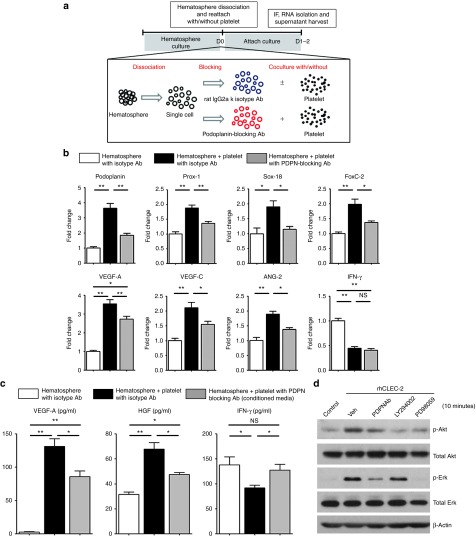Figure 4.
Human podoplanin-positive monocytes (PPMs) and platelets reciprocally activate each other via podoplanin/C-type lectin–like receptor-2 (CLEC-2) axis. (a) Experimental scheme for coculture of PPMs and platelets. Cultured PPMs were dissociated to single cells and pretreated with podoplanin blocking or isotype antibody (100 µg/ml) for 30 minutes. Cells were then divided into two groups, one receiving freshly isolated platelets while the other was treated with vehicle. Both groups were cultured for 24–48 hours. Cultured supernatant and RNA were harvested. (b) Quantitative RT-PCR of PPMs under single culture versus cocultured with platelets in the presence of isotype or podoplanin-blocking antibody. Bar graphs represent the relative expression quantity of the lymphangiogenesis-related genes. Coculture with platelets significantly induced the expression of lymphangiogenic gene expression in monocytes, which was remarkably prevented by blocking podoplanin–CLEC-2 interaction (*P < 0.05, **P < 0.01; n = 3 per experiment). (c) Enzyme-linked immunosorbent assay for lymphangiogenesis-related cytokines (VEGF-A and HGF) and antilymphangiogenesis-related cytokine (IFN-γ) in each conditioned medium of monocytes (*P < 0.05; **P < 0.01; n = 3 per experiment). (d) Analysis of cell signaling in PPMs after stimulation with CLEC-2. Stimulation of monocytes with rhCLEC-2 led to activation of Akt and Erk in western blot analysis, which was significantly prevented by PDPN Ab; starvation media (control), dimethyl sulfoxide (Veh), PDPN Ab, phosphoinositide 3-kinases inhibitor (LY294002), or MEK inhibitor (PD98059) were used in the treatment for 1 hour prior to stimulation with rhCLEC-2 (5 µg/ml, 5 minutes). HGF, hepatocyte growth factor; IFN, interferon; NS, nonsignificant; PDPN Ab, podoplanin-blocking antibody; rhCLEC-2, recombinant human C-type lectin–like receptor-2; VEGF, vascular endothelial growth factor.

